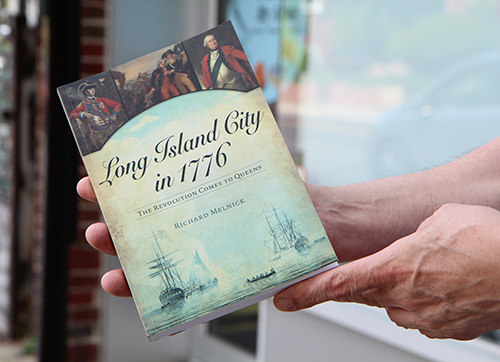At one point in the history of the history book he was writing, Richard Melnick got so fed up that he considered chucking the manuscript in the East River.
He’s still not sure why he didn’t.

Richard’s a doorman on the Upper East Side.
It’s the first book he’s ever penned solo, and he figured it would be easy because in the past, which is what he’s passionate about, he had contributed to several other history volumes.
So confident was he of the venture that he told his editor upon signing the contract that it would only take him two years to finish the book.
“Long Island City in 1776” had other ideas: That was five and a half years ago.
To understand how this all came about, you have to start with Richard’s own personal history.
Richard, a gregarious guy who has a habit of dropping historic facts and figures into every casual conversation like exclamation points, was born in Greenpoint, Brooklyn, and grew up in Carle Place, Long Island.
The youngest of four, he was sent to a foster home with two of his siblings when he was about 1.
The family’s oldest child was raised in a different foster home; Richard didn’t know of her existence until he was about 12.
“It’s a success story, not a sob story,” he says. “I had the greatest upbringing.”

Richard’s book was 5.5 years in the making.
It just so happened that Richard’s foster father was a bit of a historian and an avid traveler – he worked for Pan Am and took the family on vacations all over the country.
“He was always explaining historic events to me, and when I didn’t understand something, he told me to go to the archive – our set of encyclopedias,” Richard says.
After majoring in political science at St. John’s University, Richard wasn’t exactly sure what he wanted to do with the rest of his life.
It was his girlfriend who pushed him to decide.
She wanted to get married. He wasn’t ready.
She left him; he joined the army.
“I wanted to get away from New York City,” he says. “I spent three years in West Germany. I visited 14 countries and didn’t save a dime but I had access to the riches of Europe, and I immersed myself in history.”
When his tour of duty ended, Richard came back to New York, where he has been a doorman for the same luxury building on the Upper East Side ever since.
He works the overnight shift, which allows him to read and reflect when things are slow.
“You have to embrace the night, or it will slay you,” he says.
In 1995, he moved to Astoria to be close to his job.
For many years, he was on the board of the Greater Astoria Historical Society, where he worked on half a dozen book projects.
A licensed New York City tour guide, he reveled in revealing the city’s history to visitors.
The idea for “Long Island City in 1776” was born all the way back in 2014.
“My father and I had been discussing writing a book together,” he says. “I also felt I needed to secure my specialty in the field or I would accomplish nothing.”
Richard decided to focus on the American Revolution in 1776, the year the war ramped up in New York City and Long Island, areas he says he knows “exceptionally well.”
Richard, who just turned 63, has kayaked on the East River 30 to 40 times, so he’s familiar with the difficulties it presented to British troops that were trying to navigate its troublesome, unpredictable waters.

Richard’s kayaked on the East River 30 to 40 times.
In 2017, he got the book contract with The History Press, which called for 40,000 words.
Richard couldn’t stop himself – he wrote 162,000.
In what he considers a great victory, he got the publisher up to 61,000.
He painstakingly and reluctantly edited it down.
Each cut was a stab in the heart.
Many of his choice words, however, will live again in his second volume, which will continue 1776’s narrative and cover Long Island City from 1777 to the present.

He’s already working on volume No. 2.
“I gathered so much information that it would be monumentally unwise not to write a second book,” he says, adding that “it will be dynamic because it will show the roads and places that still exist if you know where to find them.”
This time, he swears, he really will finish it in only two years.
Richard hopes that “Long Island City in 1776” will make history come alive for readers and encourage them to pursue their own history projects.
The book came out in June, and when Richard opened the first box, he cried.
“I didn’t think it was ever going to happen,” he says.
Copyright 2023 by Nancy A. Ruhling
